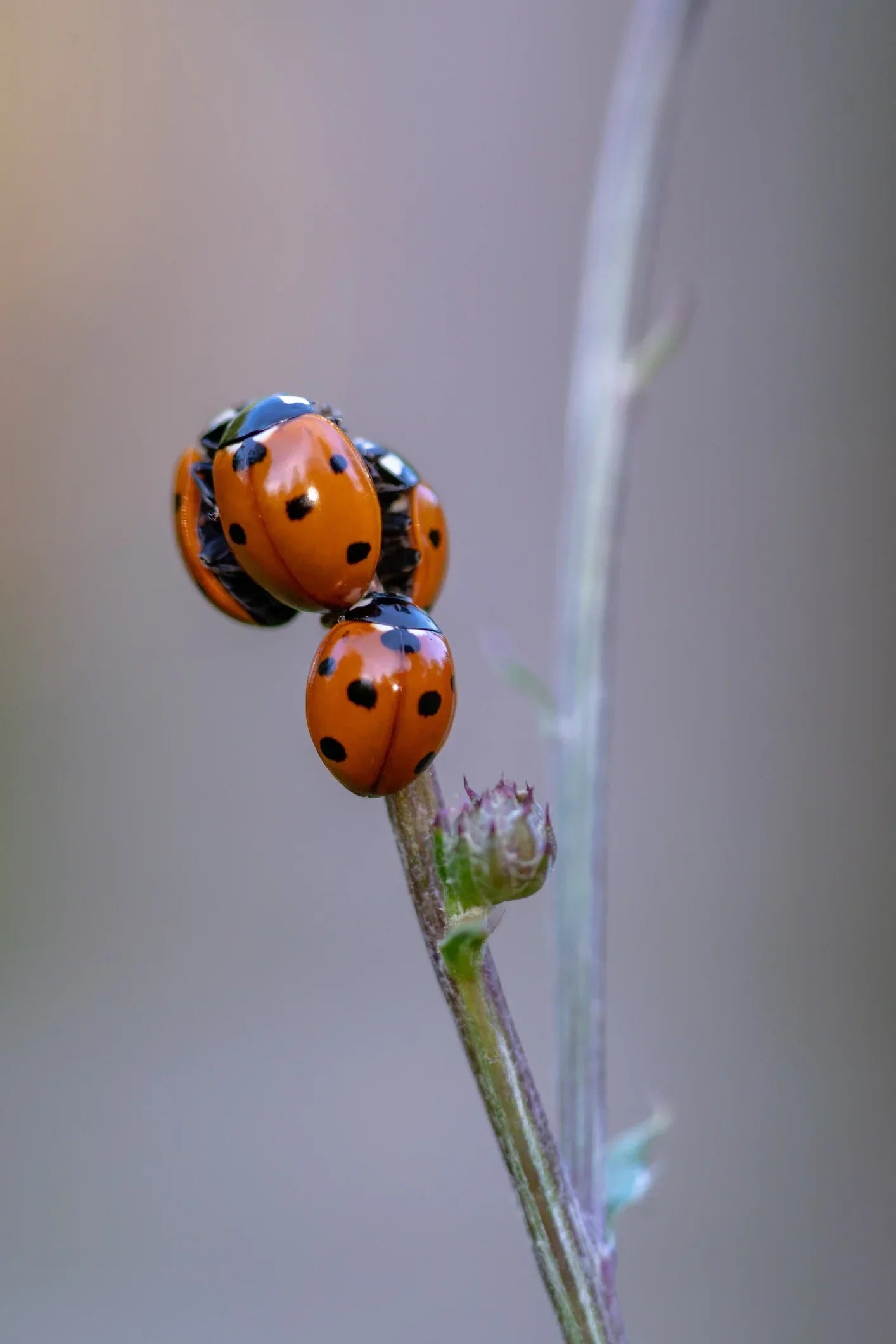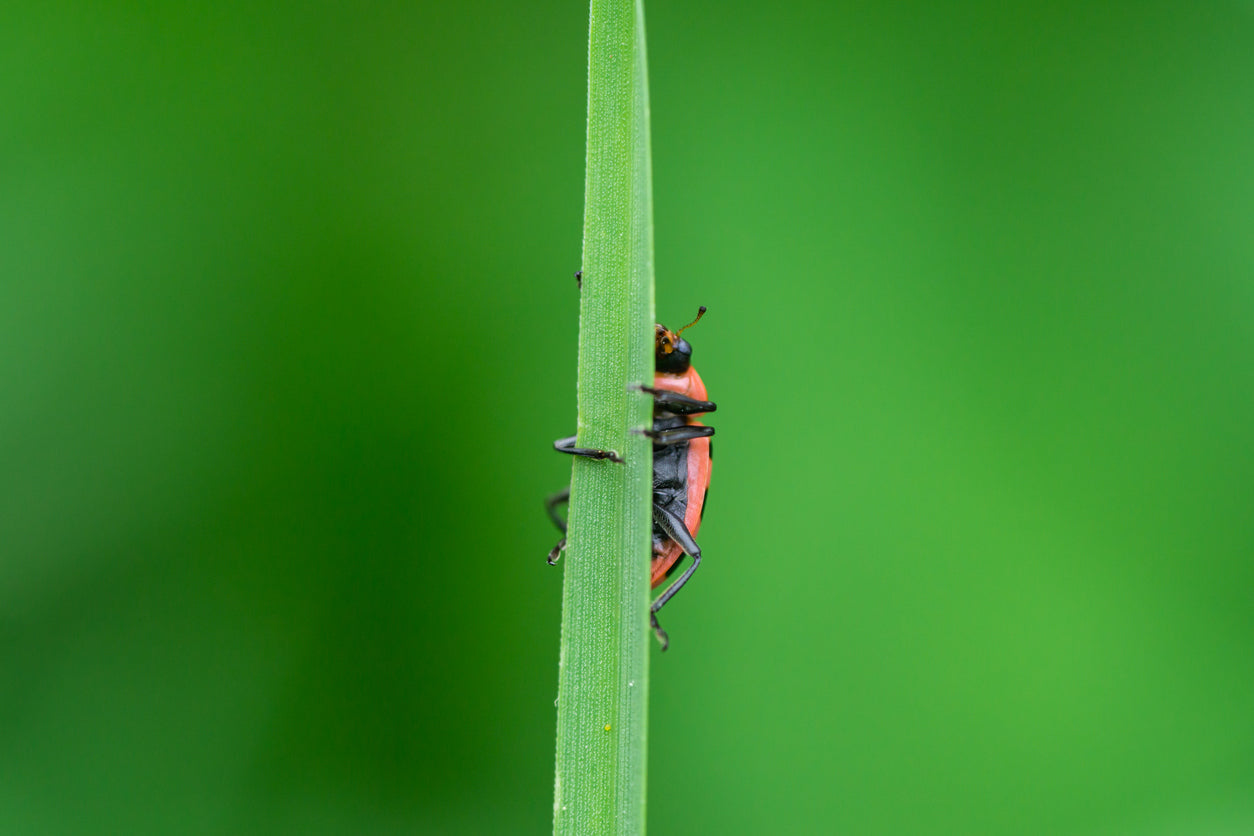Add description, images, menus and links to your mega menu
A column with no settings can be used as a spacer
Link to your collections, sales and even external links
Add up to five columns
Add description, images, menus and links to your mega menu
A column with no settings can be used as a spacer
Link to your collections, sales and even external links
Add up to five columns

5 Fascinating Ladybug Behaviors
By Spencer McManamna March 25, 2024 9 min read
Our lucky ladybug friends are full of surprises! In this article, you'll learn about their ability to hunt prey, how they survive the extreme cold, where and how they migrate and even the many hidden ways they defend themselves from predators!
Adaptive Behavior
In the context of ladybug hibernation behavior, "aggregation" refers to the clustering of ladybugs in large numbers during the winter months to seek shelter and conserve energy. Ladybugs often aggregate in protected locations such as leaf litter, tree bark crevices, or inside buildings to overwinter. Aggregation helps ladybugs conserve body heat and reduce moisture loss, allowing them to survive harsh winter conditions more effectively.
During aggregation, ladybugs release aggregation pheromones that attract other ladybugs to the same sheltered locations. As more ladybugs gather in these sites, they form dense clusters or aggregations, providing additional insulation and protection from predators and adverse weather. Aggregation behavior is essential for ladybugs to survive through the winter months when food sources are scarce and temperatures are low.
"Diapause," on the other hand, refers to a period of dormancy or suspended development that many insects enter to survive adverse environmental conditions, such as cold temperatures or drought. Diapause allows insects to conserve energy and withstand unfavorable conditions until more favorable conditions return. In the case of ladybugs, diapause typically occurs during the winter months when temperatures drop, food sources become limited, and daylight hours decrease.
During diapause, ladybugs enter a state of reduced metabolic activity, slowing down their physiological processes and conserving energy. Ladybugs in diapause may seek out sheltered locations for aggregation, where they can hibernate collectively and benefit from the insulating properties of aggregating in large numbers. Diapause allows ladybugs to survive through the winter months without needing to actively forage for food or reproduce, enabling them to resume normal activity and reproduction when conditions become more favorable in the spring.
Some ladybugs even choose to migrate to warmer climates to escape the cold! Skip to #5 to learn more about their migration!
Predatory Behavior
Ladybugs are well-known for their role as natural predators of aphids, which are small, sap-sucking insects that can damage crops and ornamental plants. Ladybugs play a vital role in controlling aphid populations through both their predatory behavior and their impact on aphid behavior and reproduction.
Ladybugs are voracious predators of aphids and other soft-bodied insects. They have specialized mouthparts designed for piercing and sucking, allowing them to consume aphids efficiently. Ladybugs are capable of consuming large numbers of aphids in a relatively short period, helping to reduce aphid populations and prevent infestations.
Ladybugs employ an efficient hunting strategy to locate and capture aphids. They use their keen sense of smell to detect aphid pheromones and locate infested plants. Once they find a suitable aphid colony, ladybugs use their agile movements and fast reflexes to capture and consume aphids rapidly. This predatory behavior helps to keep aphid populations in check and prevent outbreaks.
Ladybugs are considered valuable biological control agents for aphids in agriculture and horticulture. Many farmers and gardeners rely on ladybugs as a natural and environmentally friendly alternative to chemical pesticides for managing aphid infestations. By releasing ladybugs into aphid-infested areas, farmers and gardeners can harness the natural predatory abilities of these insects to reduce aphid populations and protect crops.
Ladybugs often synchronize their life cycles with aphid populations, ensuring that they are present when aphid numbers are highest. Ladybugs lay their eggs near aphid colonies, providing a readily available food source for their larvae once they hatch. This synchronization helps to maximize the impact of ladybug predation on aphid populations and contributes to effective aphid population control.
Overall, ladybugs play a crucial role in controlling aphid populations through their predatory behavior, efficient hunting strategy, biological control capabilities, behavioral interactions, and life cycle synchronization. By preying on aphids and influencing their behavior and reproduction, ladybugs help to maintain ecological balance and protect plants from aphid damage in natural and agricultural ecosystems.
Ladybugs, like many other predators, may employ camouflage as a strategy to access aphid colonies tended by ants. This strategy allows ladybugs to avoid detection by ants, which are known to aggressively defend aphid colonies from predators and other threats. Ladybugs may use several camouflage tactics to blend in with their surroundings and avoid detection by ants.
Some species of ladybugs exhibit coloration and patterns that resemble the appearance of aphids or other harmless insects. By mimicking the visual cues of aphids, ladybugs can avoid being recognized as potential predators by ants. This mimicry makes it easier for ladybugs to infiltrate aphid colonies without arousing suspicion from ants
Some ladybugs may produce chemicals or pheromones that mimic the scent of aphids or disrupt the chemical signals used by ants to detect predators. By masking their own scent or emitting aphid-like chemicals, ladybugs can confuse ants and avoid detection while approaching aphid colonies. This allows ladybugs to efficiently prey on aphids and contribute to natural pest control in agricultural and ecological settings.
Here are just a few of the destructive pests ladybugs feed on:
- Aphids
- Mites
- Mealybugs
- Potato Bugs
- Corn Worms
- Gnats
- Scale Insects
Foraging Behavior
"Optimal foraging theory" is a framework used in ecology and behavioral ecology to understand how animals make foraging decisions to maximize their fitness, or reproductive success, while minimizing the costs associated with obtaining food. The theory suggests that animals will adopt foraging strategies that maximize their net energy gain per unit time spent foraging.
In the context of ladybug foraging, optimal foraging theory can be applied to understand how ladybugs search for, capture, and consume aphids, their primary prey. Ladybugs are efficient predators of aphids and exhibit behaviors that optimize their foraging success:
Prey Selection
Ladybugs often preferentially target aphid colonies with high densities of aphids. By focusing their foraging efforts on areas with abundant prey, ladybugs can maximize their energy intake and minimize the time and energy spent searching for food. This prey selection strategy is consistent with the predictions of optimal foraging theory, which suggests that animals should prioritize food sources that offer the highest energy return relative to the cost of obtaining them.
Patch Foraging
Ladybugs may engage in patch foraging, where they exploit localized patches of aphid colonies before moving on to new foraging areas. Patch foraging allows ladybugs to efficiently exploit concentrated food sources and maximize their foraging efficiency. By concentrating their foraging efforts in areas with high aphid densities, ladybugs can minimize travel time and energy expenditure between feeding sites.
Energy Maximization
Ladybugs aim to maximize their net energy gain by optimizing their foraging behavior. This may involve balancing the energy expended during foraging activities, such as searching for prey, capturing aphids, and digesting food, with the energy gained from consuming aphids. Ladybugs may adjust their foraging strategies based on factors such as prey availability, environmental conditions, and metabolic demands to maximize their overall fitness.
Ladybug larvae play an essential role in foraging behavior by actively hunting and consuming aphids. Ladybug larvae are voracious predators and often exhibit more aggressive foraging behavior than adult ladybugs. They actively search for aphid colonies, capture individual aphids using their specialized mouthparts, and consume them to fuel their growth and development. Ladybug larvae may also engage in ambush predation, where they lie in wait near aphid-infested plants and capture passing aphids.
Optimal foraging theory provides a framework for understanding how ladybugs enhance their foraging behavior to maximize energy intake and reproductive success while minimizing costs. Ladybugs employ strategies such as prey selection, patch foraging, and energy maximization to efficiently hunt for aphids, their primary prey. Ladybug larvae contribute to foraging efforts by actively hunting and consuming aphids to support their growth and development.

Defensive Behavior
Aposematic coloring refers to the bright, conspicuous coloration displayed by certain animals as a warning signal to potential predators. These colors serve as a visual cue to predators, indicating that the animal possesses chemical defenses, toxins, or other deterrents that make it unpalatable or harmful to consume. Aposematic coloration acts as a form of warning advertisement, effectively communicating to predators that attacking or consuming the animal will result in negative consequences.
In the case of ladybugs, their color patterns often exhibit aposematic coloring, characterized by bright red or orange elytra (wing covers) with contrasting black spots or markings. Ladybugs typically display their wings and color patterns prominently when threatened, signaling their aposematic defenses to potential predators. The conspicuous coloration of ladybugs serves as a warning signal to predators, indicating that they possess distasteful or toxic compounds that deter predation.
The bright red or orange coloration of ladybugs is often associated with the presence of defensive chemicals, such as alkaloids or glycosides, which are sequestered from their diet of aphids or other prey. These chemical compounds can be distasteful, irritating, or toxic to predators, making ladybugs unattractive or harmful targets for consumption. Ladybugs may also engage in reflex bleeding, where they release hemolymph (blood) containing these defensive compounds when threatened, further reinforcing their aposematic defenses.
Of course, that's not the little ladybug's only form of defense: a pair of powerful wings give it the ability to quickly escape all but the fastest predators!
Migratory Behavior
Ladybug migrations vary in frequency depending on factors such as species, geographic location, and environmental conditions. While some ladybug species exhibit regular or seasonal migration patterns, others may migrate infrequently or opportunistically in response to specific triggers or stimuli.
Ladybugs migrate in search of suitable food sources, particularly aphids and other soft-bodied insects that serve as their primary prey. When aphid populations decline or become depleted in their current habitat, ladybugs may migrate to new areas where prey is more abundant. This is especially common during the spring and summer months when aphid populations are high and ladybugs need to feed and reproduce.
Ladybugs are ectothermic organisms, meaning their body temperature is regulated by external environmental conditions. Temperature plays a crucial role in determining the activity and movement of ladybugs. In cooler climates, ladybugs may migrate to warmer areas to escape cold temperatures and ensure their survival. Conversely, in warmer climates, ladybugs may migrate to cooler, more temperate habitats to avoid heat stress or dehydration.
Ladybugs may migrate to specific locations to engage in mating and reproduction. Some species aggregate in large numbers at mating sites, where males and females come together to mate and lay eggs. Migratory behavior during the mating season allows ladybugs to find suitable mates and establish new colonies in favorable breeding habitats.
Human activities, such as urbanization, agriculture, deforestation, and pesticide use, can disrupt ladybug habitats and trigger migrations. Habitat disturbance may result in loss of food sources, habitat fragmentation, or exposure to harmful chemicals, forcing ladybugs to relocate to more suitable environments.
Ladybug migrations may be influenced by natural phenomena such as weather events, wind patterns, or seasonal fluctuations. Some ladybug species engage in long-distance migrations, often facilitated by favorable wind currents or atmospheric conditions. These mass migrations, known as ladybug swarms or blooms, can involve millions of individuals traveling over long distances in search of food, mates, or suitable breeding sites.
Ladybug "swarming" behavior refers to the phenomenon where large numbers of ladybugs aggregate and migrate together in dense clusters, often covering vast distances in search of suitable habitats, food sources, or mates. Ladybug swarms are spectacular natural events that can involve millions of individuals and are characterized by their conspicuous presence and synchronized movements. Here are some key aspects of ladybug swarming behavior and examples of notable swarming events:
Mass Aggregation
Ladybugs often aggregate in massive numbers during swarming events, forming dense clusters that can cover trees, buildings, and other structures. These aggregations may consist of multiple species of ladybugs, with individuals gathering together to benefit from the collective protection and resources provided by the swarm.
Long-Distance Migration
Ladybug swarms can involve long-distance migrations spanning hundreds or even thousands of kilometers. Swarming ladybugs may travel over land or water, propelled by favorable wind currents or atmospheric conditions. These migratory movements allow ladybugs to find new habitats, exploit seasonal resources, or engage in mating and reproductive behaviors.
Seasonal Patterns
Ladybug swarming behavior often follows seasonal patterns, with swarms occurring during specific times of the year corresponding to periods of high activity, reproduction, or environmental change. In temperate regions, ladybug swarms are commonly observed in the spring and fall, coinciding with the onset of warmer weather, increased prey availability, or migratory movements.
Mating Aggregations
Ladybug swarms may serve as mating aggregations, where males and females come together to mate and reproduce. Swarming individuals release pheromones and engage in courtship behaviors to attract mates and ensure successful reproduction. Mating aggregations provide ladybugs with opportunities to find suitable mates and establish new colonies in favorable breeding habitats.
Ecological Significance
Ladybug swarms play important ecological roles in pest control, pollination, and nutrient cycling. Swarming ladybugs consume vast numbers of aphids and other soft-bodied insects, helping to regulate pest populations and maintain ecosystem balance. Additionally, ladybugs serve as pollinators for certain plants and contribute to soil fertility through their interactions with other organisms.
Examples of notable ladybug swarming events include:
- The annual ladybug migration in North America, where millions of ladybugs migrate from the Sierra Nevada Mountains to the Central Valley of California in the fall.
- The convergence of multiple ladybug species in the mountains of Japan during the spring, forming dense swarms known as "ladybug waterfalls."
- The mass migration of ladybugs across the Strait of Gibraltar in Europe, where swarms of ladybugs travel between continents in search of seasonal habitats and resources.
Discover the Fascinating Behavior of Ladybugs
The search for ladybug knowledge never ends! Take a deep dive into life cycle learning with Insect Lore's Ladybug Land® habitat kits.
Related products
Also in Ladybugs

All About Ladybugs, Climate and Temperature
October 10, 2024 4 min read
Nature lovers have often wondered how our little ladybug friends manage to survive a season that can often be quite harsh for insects. Read on to discover how ladybugs survive and thrive in both high and low temperatures, and what the future holds for them with the approach of climate change.

Enter Your Voucher Code Below
If you are experiencing difficulty redeeming your voucher on your desktop, please use a mobile device for a better redeeming experience.

We are unable to combine redemption fees. If you are redeeming 1-5 voucher codes, please complete separate purchases through our website for each voucher. If you are redeeming 6+ vouchers, please email us at customerservice@insectlore.com with your voucher codes and shipping address and we'll send you a custom invoice for payment.
Thank you for Redeeming your voucher!
You redeemed a $title

Don't miss this special one Time Offer.
Check the Box to Add this Special Offer to your Cart

Don't miss this special one Time Offer.
Check the Box to Add this Special Offer to your Cart
It looks like you are an Insect Lore UK/EU customer! You are visiting the Insect Lore USA website.
Click Insect Lore UK/EU website to be redirected to insectlore.co.uk.






